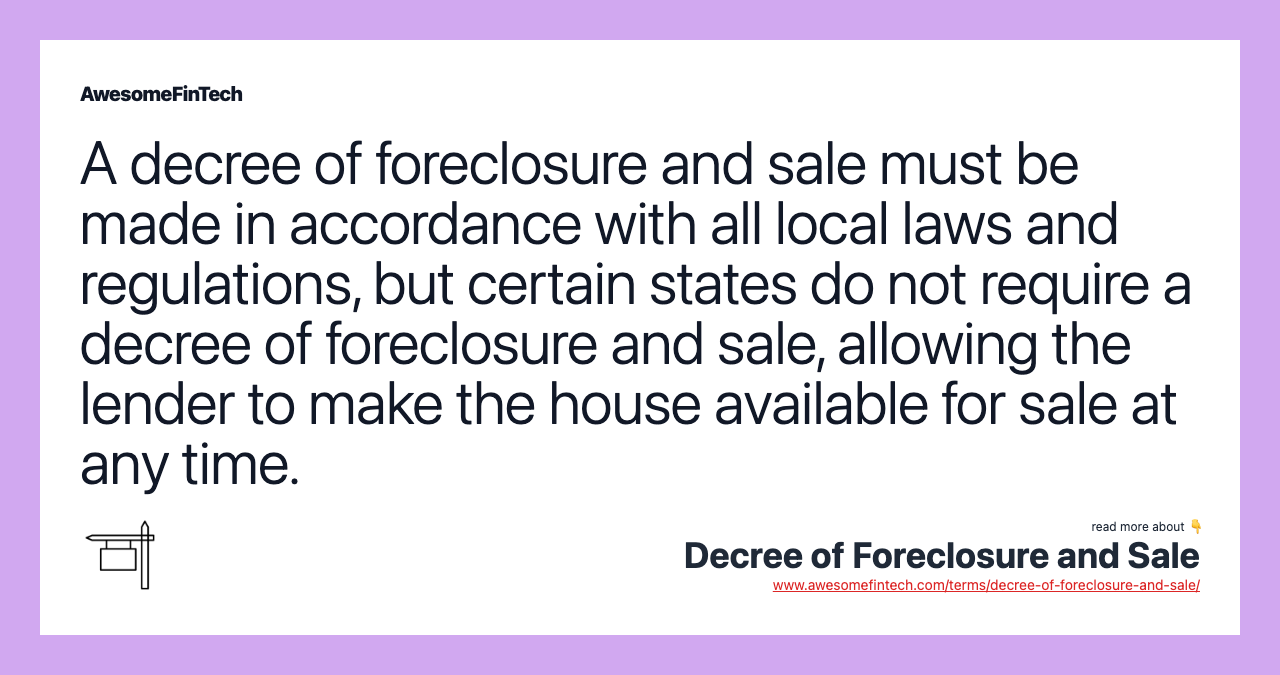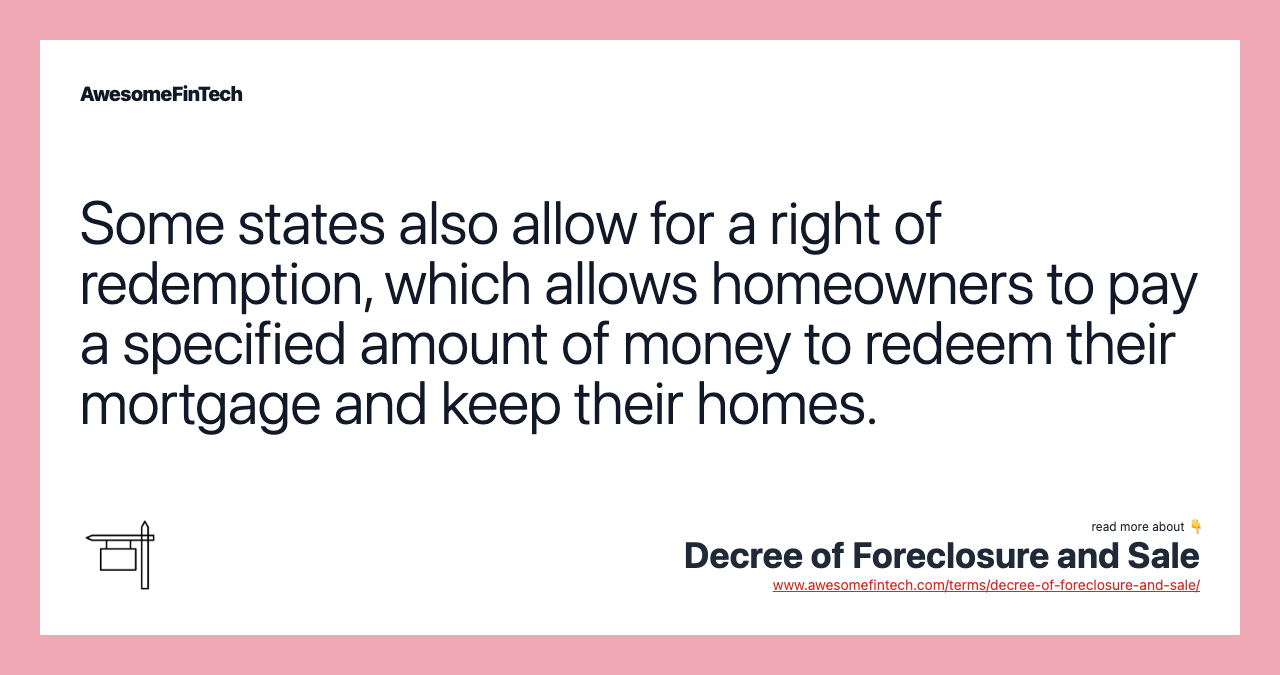Decree of Foreclosure and Sale
A decree of foreclosure and sale, sometimes simply called a decree of foreclosure, is a declaration made by a court indicating the amount of outstanding debt that a borrower has defaulted on and that their property will be sold to cover the outstanding debt. A decree of foreclosure and sale must be made in accordance with all local laws and regulations, but certain states do not require a decree of foreclosure and sale, allowing the lender to make the house available for sale at any time. Some states provide a statutory right of redemption, which allows homeowners to redeem their mortgages after the foreclosure sale by paying the foreclosure sale price of the home, along with any interest and fees, to its purchaser. A decree of foreclosure and sale, sometimes simply called a decree of foreclosure, is a declaration made by a court indicating the amount of outstanding debt that a borrower has defaulted on and that their property will be sold to cover the outstanding debt. With any right of redemption, the borrower must act to redeem their mortgage within the time period specified by local law, and it is always advised to first contact your bank before multiple payments have lapsed to find a resolution before a decree of foreclosure and sale has been issued.

What Is a Decree of Foreclosure and Sale?
A decree of foreclosure and sale, sometimes simply called a decree of foreclosure, is a declaration made by a court indicating the amount of outstanding debt that a borrower has defaulted on and that their property will be sold to cover the outstanding debt. These declarations are required by law in some states for a lender to proceed with a foreclosure.



Understanding Decrees of Foreclosure and Sale
Lenders foreclose on properties when the borrower defaults on their loan after failing to make payments for an extended period of time. When a borrower obtains a mortgage to buy a home, the property serves as collateral for the loan.
In the event that the borrower defaults, the lender assumes possession of the home and forecloses on the property. Foreclosed homes tend to be auctioned at sheriff’s sales. The proceeds from the sale of the home go to the mortgage lender to recoup the cost of the loan.
A decree of foreclosure and sale must be made according to any local laws and regulations and within the terms of the associated mortgage. When the decree is made, the borrower receives written notice of the outstanding debt and that the property is to be auctioned off. The amount recovered from the auction goes to cover unpaid interest and principal, as well as the lender’s legal bills.
Rights of Redemption With a Decree of Foreclosure and Sale
Some states allow borrowers a right of redemption. This right allows homeowners in foreclosure to pay a specified amount of money to redeem their mortgages in order to keep their homes. An equitable right of redemption allows homeowners to redeem their mortgages by paying off the entire balance of the mortgage before a foreclosure sale. This may be done through refinancing if the borrower is able to secure a new mortgage.
Some states provide a statutory right of redemption, which allows homeowners to redeem their mortgages after the foreclosure sale by paying the foreclosure sale price of the home, along with any interest and fees, to its purchaser. In this way, they can regain possession of their home.
There are many programs that are offered by the U.S. Department of Housing and Urban Development that assist homeowners facing foreclosure. Some of these include programs to refinance at a lower interest rate, therefore reducing the monthly mortgage payment. Other programs help individuals who have lost their jobs and have no income to pay their mortgages.
With any right of redemption, the borrower must act to redeem their mortgage within the time period specified by local law, and it is always advised to first contact your bank before multiple payments have lapsed to find a resolution before a decree of foreclosure and sale has been issued.
Alternatives to a Decree of Foreclosure and Sale
Some states do not require judicial foreclosures. In these states, lenders are not required to obtain a decree of foreclosure through the court system. Instead, they may alert the borrower and the public of the foreclosure through other means.
These may include a notice of default followed by a notice of sale, a notice of sale specifying an auction date, or simply the publication of a notice of sale in a newspaper. In states with non-judicial foreclosures, the foreclosure process generally operates more quickly than in states requiring a court-issued decree of foreclosure.
Related terms:
Collateral , Types, & Examples
Collateral is an asset that a lender accepts as security for extending a loan. If the borrower defaults, then the lender may seize the collateral. read more
Deed of Reconveyance
Mortgage lenders issue deeds of reconveyance when the loan is paid off, releasing the borrower from any further obligation on the debt. read more
Default
A default happens when a borrower fails to repay a portion or all of a debt, including interest or principal. read more
Foreclosure Action
The legal proceedings initiated by a lender in the case of mortgage default. read more
Foreclosure
Foreclosure is the legal process by which a lender seizes and sells a home or property after a borrower is unable to fulfill their repayment obligation. read more
Judicial Foreclosure
Judicial foreclosure involves the courts to settle a mortgage foreclosure. read more
Mortgage
A mortgage is a loan typically used to buy a home or other piece of real estate for which that property then serves as collateral. read more
Pre-Foreclosure
Pre-foreclosure refers to the early stage of a property being repossessed due to the property owner’s mortgage default. read more